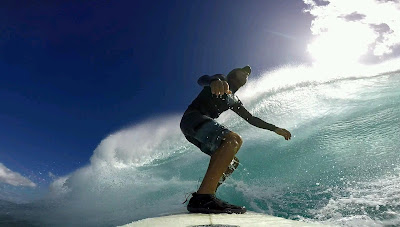Chasing waves is what I'm doing here in Indo, so I thought about starting this post with that quote out of the book Barbarian Days: A Surfing Life, written by William Finnegan.
As far as surfing books written by surfers go, I don't think it can get any better than this. Finnegan is in fact an excellent writer with a degree in English and I absolutely loved the words he chose to describe things and feelings I very much identified myself with. For me the book was a clear 10 and I recommend it strongly.
Here I'm reading it while sipping a tea and resting between session.
And after an unusual non chronological post start, let me go back to where I left you guys at.
As you might remember from the last post, I was about to go to my favorite spot based on a really good forecast.
This warning on the screen at the airport threw some water (almost literally) on the fire of my excitement. The translator app on my phone, in fact, offered an alarming outcome to my nervous query: "EARTHQUAKE AND TSUNAMI"
Fortunately the final words Tidak Berpotensi (no potential) were more reassuring, but I did get online to research about it. Yes to the earthquake, no to the tsunami was the result, so off I went.

Love the flashiness of the local Bemos.

This time of the year the place usually has a particular dry weather and the light is hence outstanding. Check the beautiful color of the cloudless sky.
That's a classic low tide sunset. One of the few I didn't watch from the water.

I found a nice Australian surf magazine called White Horses at the camp and I knew right away this photo was from my friend Ben Thouard.

But let's get down to business and let me claim that the forecast analysis on which I based my travel planning was spot on. The swell arrived when I thought, got as big as I thought and lasted as long as I thought. The winds were favorable (offshore and not too strong) and overall the quality of the rides were excellent for at least 5 days in a row.
I'm gonna throw down a first gopro shot here to substantiate the above pronouncement. Good thing I didn't know the lip behind me looked like that.

Unfortunately, once again, after three days of intense action, I got a cold that kept me at bay for a couple of days. This is something that happens to me regularly in Indonesia. It's not any kind of tropical disease. It's just that I surf too much and become overly tired, my immune system goes low and I catch a cold or a caugh or a sore throat or a fever or whatever of the many bugs that obviously circulate in a tropical surf camp.
The weird thing is that I don't surf more than what I do in Maui. I know my limits and I'm usually good at sticking to them. Two sessions a day for a maximum of 4 hours total (ok, 5 if really epic) and plenty rest in between.
But it's now evident that surfing in Indonesia drains and weakens me more than in Maui. The two things I can blame that to are: environment and food. I can't really change either one (specially when not in Bali, I have to eat what's available), so the only way to try to stay healthy would be to surf less.
I can do that of course, but that's so hard when I'm on my favorite wave in the world, the conditions are pristine and I'm surfing the same amount of time that I'm mentally and physically used to.
Let's see how I do next time, which, as you guys are about to learn, is coming up shortly.
But before we get to that, let me first finish the photo report of the amazing waves of this section of the trip. This place is really hard to photograph from the beach because the wave is too far out. I could have got on a boat, but I was either resting between sessions or recovering from the cold, so - sorry - but I didn't feel like and you'll have to live with the following three shots.
A nice set breaks on the reef while a typical local boat leaves the shore. There's a guy on the wave out the back. Click on the photo to see him.
Same guy preparing a cutback, now you can see him better because the wave in front got smaller. The wave he's on is double overhead, but the size is another thing that gets lost with the distance.
Maybe this one shows the size a little better at least. The surfer is on the first wave and that is already overhead. The one out the back is a serious bomb.
Other things that the long distance shots don't show are the perfect shape of the waves and the pristineness of the conditions. I hope that the following gopro shots will help instead.
Sorry about the repetitiveness of the framing, but I really like how dramatic the wave (particularly the lip) looks behind me, plus each single shot below is taken from a different wave... it was a really epic session.

I was riding my bigger board (a 6.10 designed by Matt Kinoshita) and the size was a solid double overhead (which means with occasional bigger sets). I got caught inside a few times, had to ditch the board, got worked a bit, but never got really scared. I was actually pleased by how well I managed not to panic while being tumbled under water. Once again, even though at that size it gets much heavier than it normally is, the place is no Pipeline.
I picked this frame below because the horizon is leveled.
I'm doing a wide bottom turn without going too much in the flats in front of the wave and I will ride the rest of it with a fast and cruisy high line. No ambition of doing sharp turns on a 6.10, and at that size I was just happy to stick the drop and make the wave which was unrolling very quickly in front of me.
Amazing adrenaline rush for my skills, as you can tell from the last steep wave of the video I posted a little below.
My favorite shot. In loving memory of my surfing hat that was taken out by a heavy lip in a duck dive later on. I thought I was gonna lose the whole head on that one, really.
Hat is gone, but I already bought a new one here in Bali. The afternoon sun and related glare are ferocious.
This is a smaller day, I'm riding the Pyzel 6.1 with which I can try to push some turns here and there. I love that wave at any size, really.
And these are a few clips from the session with the 6.10. The hum from the fins in the drop suggests a fair amount of speed (and the need for a shim).
I stayed over there only a week (that's how long the good waves lasted) and then I went back to Bali to spend a week with a friend. This photo is taken from inside the rental operation at Old Mens and I admit it was pretty hard to go back and surf Canggu after having surfed so much perfection.

But I'm not going to complain, because as soon as my friend leaves the forecast looks pretty good again and I'm going straight back to my spot, taking advantage of the two boards that I left there.
Flight is booked for Monday August 1st and this is the very promising weather map of July 28 that shows a fairly big fetch. The related swell is forecasted to peak at 6f 16s (pretty much same size as the last swell, so a couple of days of DOH+) on Wednesday the 3rd. Let's see if I manage to stay healthy.

In the meantime, I'm enjoying sunsets at the beach with good company and a cold beer.
Lastly, I'm happy to share this video about a GPS tracking device that some friends of mine are trying to push.
Let me also point out that out of a session in which he spent 3h paddling, the total amount of time a really good surfer like Keith Taboul spent actually surfing was "only" 4:49 minutes. And he caught a lot of waves!
And that's why surfing has, IMO, the slowest learning curve I have ever experienced in a sport. Sure, you get stronger muscles when you paddle and you exercise your wave reading skills while waiting, but the actual skill of putting the board on the rail and having the board go where you want it to, gets very little chance to improve per session. Yet, it's my favorite thing in the world.
Really cool device, btw. Check out the animation on the right bottom corner that simulates what the board does. The filming from shore, of course and unfortunately, doesn't come with it.
Xensr Wave Replay from Xensr on Vimeo.

















































